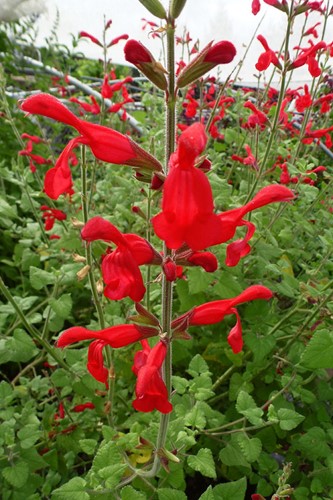Sensational Salvias (Part Two!)
Ian and Teresa Moss with another selection of amazing gems from their salvia collection. - 04 July 2025
Those of you who have followed Rare Plant Fairs for a while, or who have bought plants from us at events, will be well aware of our passion for salvias. We have a collection of over 150 varieties that we grow in our back garden here on the Welsh borders between Shropshire and Flintshire, and we propagate from our collection primarily to refresh our own collection and as an insurance against winter losses. We’ve written before for the newsletter about our collection (see our article ‘Sensational Salvias’ at the Rare Plant Fair website), but with so many to tell you about we could only include a small selection from the range that we grow. So here’s a few more of our favourites for you to enjoy, all of which we hope to have for sale at the Rare Plant Fair at Winterbourne House and Garden on July 13th.
Salvia fulgens
Salvia fulgens is a tender perennial in the UK climate (although some gardeners in the south of the country have been able to overwinter it outside in well-drained soil), but is easily propagated from cuttings. It’s a good choice for our gardens, as it will flower continuously and prolifically in the garden from June to the first frosts. The form that we have was collected on the slopes of Mount Popocatapetl, an active Mexican volcano, so it’s fair to say that its wild population may be at some risk! This form differs from other collections in that it has large bracts/calyces that offset and enhance the stunning orange-red flowers. It will grow in full sun or part shade, and will appreciate watering in an extended dry spell. Height is around 4ft (120cm). There’s always a place for this one in our garden!

Salvia oxyphora
A very beautiful salvia, this Bolivian species is extremely rare in the wild. The large, furry bright pink flowers are breathtaking, and offset by elegant, glossy green foliage. This is another salvia that is borderline hardy in the UK, but in reality plants that overwinter outside will be very late into flower and it’s a better bet to overwinter cuttings (which root easily) under glass – plants grown this way will flower throughout the summer. Height is around 4ft (120cm), and it will grow in full sun or partial shade, but is best in a sheltered spot away from strong winds.

Salvia serboana (syn. vitifolia)
We often say that there are few plant genera that do blue flowers as well as salvias, and one that helps prove the point is Salvia serboana. The flowers are not the only attraction for this salvia, however, as it also has very showy vine-like foliage (hence the synonym vitifolia). It originates from the mountain forests of the Oaxaca region in Mexico, and you might expect as a result that it would be tender, but it is a hardy perennial in the UK provided that it is grown in well-drained soil. In favourable conditions it can reach 6ft (180cm), but again 4ft (120cm) in more likely. Probably best in partial shade, it appears to be doing well in full sun here in our garden with a bit of extra watering. Very beautiful, and highly recommended.

Salvia stachydifolia ‘Twilight Zone’
This is a hardy, herbaceous salvia that originates from Argentina. We’ve grown it in our garden here for the last four years and it has proved to be reliably hardy, even with temperature down to -12C one year. Salvia stachydifolia grows to around 5ft (150cm) tall, and flowers for us from late June until the first frosts, and has beautiful pale blue flowers with a white throat. It can be propagated by cuttings, but also sets plenty of seed, which germinates easily. For the best flowering, keep it deadheaded (apart from a few flowerheads if you want to collect seed!) It will die right back to the ground at the first frost, but reshoots from the base in spring, usually around mid-April here.

Salvia cacaliifolia
Another wonderful blue flowering salvia, this comes from Mexico and Central America. It’s not reliably hardy in the UK, but is very easy from cuttings. It has quite a sprawling habit, and it best suited to a large container or even a hanging basket, where it will flower all summer with a mass of stunning blue flowers. The foliage is also attractive, with bright green, triangular leaves. This species is one of the parents of the hybrid ‘Blue Butterflies’ (along with S. sagittata) which has become popular in recent years.

Salvia stolonifera
Another salvia from the Oaxaca region in southern Mexico, this is nevertheless hardy in the UK, where it retreats to underground stolons for the winter months. A shorter salvia than those above, it will flower to around 2ft (60cm) above mounds of glossy green foliage, with deep orange flowers offset by dark calyces. Beautiful and easy, it can be propagated by cuttings but it’s much easier by good old division!

Salvia darcyi
A brilliant salvia from the west coast of Mexico and further north into California, S. darcyi is a stunning scarlet red salvia with large tubular flowers on tall stems to about 4-5ft (120-150cm). It’s hardy to around -6C in well-drained soil, but again is very easily propagated by cuttings. It can occasionally set seed in the UK, even though it’s pollinated by hummingbirds in the wild. The foliage is very sticky, so plant with a bit of room from its neighbours (and keep it separate in your bags on the way home!). Salvia darcyi can also cross with S. microphylla to produce beautiful hybrids, one of which, S. ‘Silkes’ Dream’, we’ll also have at Winterbourne House.

Salvia napifolia
Quite different to the other salvias mentioned so far, Salvia napifolia is a fully hardy herbaceous perennial that originates from Turkey, and has a wonderful contrast of rose pink calyces with lavender blue flowers, and gives a lovely frothy look in the border. It’s a nice compact plant, to around 2ft x 2ft (60cm x 60cm)

Salvia mexicana ‘Lolita’
Finally, a variety that we have mentioned before, but it’s so good it needs to be included again. There are no prizes for guessing where S. mexicana comes from! Everything about this variety is wonderful – the foliage, large glossy, hearted-shaped leaves, is beautiful in its own right, and in late summer and early autumn the plant produces long flower spikes of lime-green buds, which open to reveal gorgeous purple-blue flowers that contrast brilliantly with the lime-green calyces. ‘Lolita’ is a ‘dwarf’ selection of S. mexicana, but still makes around 7ft (210cm) up and about 4ft (120cm) across from a late May planting. Other selections of S. mexicana can flower too late to be useful in our climate, so selections should be chosen carefully. It’s not hardy, but again it’s very easy from cuttings, and (much to our surprise!) we’ve had several self-seeded plants pop up in the garden every year since we’ve been here. This is a wonderful plant that’s worth its place in any garden.

A Word About Overwintering Salvias
We talked about this in our last article, but it’s worth covering the topic again as so many people that we talk to at Fairs are nervous about taking cuttings and overwintering tender plants. it couldn't be easier and you don't need a lot of space. We take most of our cuttings as softwood cuttings throughout the summer, and the vast majority root extremely easily. We actually root all of ours in water, just in small glass jars or shot glasses.

Propagation of our salvias in full swing!
Most root within 2 weeks, and can then be potted up for overwintering. We take cuttings at any time from April to September – the only difference will be the size of plant that you’ll have to overwinter (early cuttings will be full size plants in 2-3lt pots, later cuttings will be in 7 or 9cm pots). Time your cuttings to suit the space available to you.

Rooted cuttings of Salvia 'Violette de Loire', rooted in water.
Plants can of course be overwintered in a frost-free greenhouse if you have one, but a small collection would not need much space and could even be accommodated on a kitchen windowsill or in your porch. So don't be put off growing tender salvias - they are easy to keep going from one year to the next and are well worth the effort!
Ian and Teresa Moss are retired nursery owners and obsessive compulsive gardeners. Although they propagate salvias primarily for their own collection, they do sell surplus plants through Plant Fairs or collection from their home on the Welsh borders. Full details can be found on their website.
Website: https://hardyandunusualplants.wordpress.com/
Fairs
Past Fairs:

 Handy Plants for Climate Change - Read More..
Handy Plants for Climate Change - Read More..
 Hard-working Plants for Late Summer and Autumn Colour - Read More..
Hard-working Plants for Late Summer and Autumn Colour - Read More..
 Perennial: Supporting people in horticulture across the UK - Read More..
Perennial: Supporting people in horticulture across the UK - Read More..
 2026 Rare Plant Fair Dates - Read More..
2026 Rare Plant Fair Dates - Read More..
 The Manor House Garden, Bledlow - Read More..
The Manor House Garden, Bledlow - Read More..